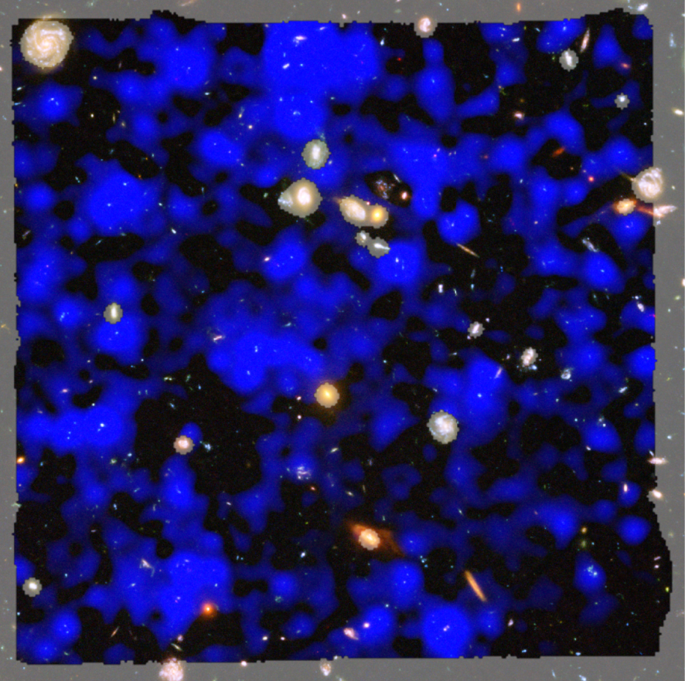Our official English website, www.x-mol.net, welcomes your feedback! (Note: you will need to create a separate account there.)
Nearly all the sky is covered by Lyman-α emission around high-redshift galaxies
Nature ( IF 64.8 ) Pub Date : 2018-10-01 , DOI: 10.1038/s41586-018-0564-6 L. Wisotzki , R. Bacon , J. Brinchmann , S. Cantalupo , P. Richter , J. Schaye , K. B. Schmidt , T. Urrutia , P. M. Weilbacher , M. Akhlaghi , N. Bouché , T. Contini , B. Guiderdoni , E. C. Herenz , H. Inami , J. Kerutt , F. Leclercq , R. A. Marino , M. Maseda , A. Monreal-Ibero , T. Nanayakkara , J. Richard , R. Saust , M. Steinmetz , M. Wendt
Nature ( IF 64.8 ) Pub Date : 2018-10-01 , DOI: 10.1038/s41586-018-0564-6 L. Wisotzki , R. Bacon , J. Brinchmann , S. Cantalupo , P. Richter , J. Schaye , K. B. Schmidt , T. Urrutia , P. M. Weilbacher , M. Akhlaghi , N. Bouché , T. Contini , B. Guiderdoni , E. C. Herenz , H. Inami , J. Kerutt , F. Leclercq , R. A. Marino , M. Maseda , A. Monreal-Ibero , T. Nanayakkara , J. Richard , R. Saust , M. Steinmetz , M. Wendt

|
Galaxies are surrounded by large reservoirs of gas, mostly hydrogen, that are fed by inflows from the intergalactic medium and by outflows from galactic winds. Absorption-line measurements along the lines of sight to bright and rare background quasars indicate that this circumgalactic medium extends far beyond the starlight seen in galaxies, but very little is known about its spatial distribution. The Lyman-α transition of atomic hydrogen at a wavelength of 121.6 nanometres is an important tracer of warm (about 104 kelvin) gas in and around galaxies, especially at cosmological redshifts greater than about 1.6 at which the spectral line becomes observable from the ground. Tracing cosmic hydrogen through its Lyman-α emission has been a long-standing goal of observational astrophysics1–3, but the extremely low surface brightness of the spatially extended emission is a formidable obstacle. A new window into circumgalactic environments was recently opened by the discovery of ubiquitous extended Lyman-α emission from hydrogen around high-redshift galaxies4,5. Such measurements were previously limited to especially favourable systems6–8 or to the use of massive statistical averaging9,10 because of the faintness of this emission. Here we report observations of low-surface-brightness Lyman-α emission surrounding faint galaxies at redshifts between 3 and 6. We find that the projected sky coverage approaches 100 per cent. The corresponding rate of incidence (the mean number of Lyman-α emitters penetrated by any arbitrary line of sight) is well above unity and similar to the incidence rate of high-column-density absorbers frequently detected in the spectra of distant quasars11–14. This similarity suggests that most circumgalactic atomic hydrogen at these redshifts has now been detected in emission.Lyman-α emission from atomic hydrogen shows the location of warm gas and is ubiquitous around galaxies between redshifts of 3 and 6, thereby covering nearly all the sky.
中文翻译:

几乎所有的天空都被高红移星系周围的莱曼α辐射所覆盖
星系周围环绕着大量的气体,主要是氢气,它们由来自星系际介质的流入和来自星系风的流出供给。沿着明亮和稀有背景类星体的视线的吸收线测量表明,这种环绕星系的介质远远超出了星系中看到的星光,但对其空间分布知之甚少。原子氢在 121.6 纳米波长处的莱曼-α 跃迁是星系内部和周围温暖(约 104 开尔文)气体的重要示踪剂,特别是在大于约 1.6 的宇宙学红移时,光谱线在地面上变得可观察到。通过其 Lyman-α 发射追踪宇宙氢一直是观测天体物理学 1-3 的长期目标,但空间扩展发射的极低表面亮度是一个巨大的障碍。最近发现高红移星系周围的氢普遍存在扩展的 Lyman-α 辐射,从而打开了了解环星系环境的新窗口 4,5。由于这种发射的微弱,此类测量以前仅限于特别有利的系统 6-8 或使用大量统计平均 9,10。在这里,我们报告了在 3 到 6 之间红移时对微弱星系周围的低表面亮度莱曼-α 发射的观察结果。我们发现预计的天空覆盖率接近 100%。相应的入射率(任何任意视线穿透的 Lyman-α 发射器的平均数量)远高于 1,并且类似于在遥远类星体 11-14 的光谱中经常检测到的高柱密度吸收器的发生率。这种相似性表明,这些红移处的大多数环银河原子氢现在已在发射中被检测到。来自原子氢的莱曼-α 发射显示了温暖气体的位置,并且在红移 3 和 6 之间的星系周围无处不在,因此几乎覆盖了整个天空。
更新日期:2018-10-01
中文翻译:

几乎所有的天空都被高红移星系周围的莱曼α辐射所覆盖
星系周围环绕着大量的气体,主要是氢气,它们由来自星系际介质的流入和来自星系风的流出供给。沿着明亮和稀有背景类星体的视线的吸收线测量表明,这种环绕星系的介质远远超出了星系中看到的星光,但对其空间分布知之甚少。原子氢在 121.6 纳米波长处的莱曼-α 跃迁是星系内部和周围温暖(约 104 开尔文)气体的重要示踪剂,特别是在大于约 1.6 的宇宙学红移时,光谱线在地面上变得可观察到。通过其 Lyman-α 发射追踪宇宙氢一直是观测天体物理学 1-3 的长期目标,但空间扩展发射的极低表面亮度是一个巨大的障碍。最近发现高红移星系周围的氢普遍存在扩展的 Lyman-α 辐射,从而打开了了解环星系环境的新窗口 4,5。由于这种发射的微弱,此类测量以前仅限于特别有利的系统 6-8 或使用大量统计平均 9,10。在这里,我们报告了在 3 到 6 之间红移时对微弱星系周围的低表面亮度莱曼-α 发射的观察结果。我们发现预计的天空覆盖率接近 100%。相应的入射率(任何任意视线穿透的 Lyman-α 发射器的平均数量)远高于 1,并且类似于在遥远类星体 11-14 的光谱中经常检测到的高柱密度吸收器的发生率。这种相似性表明,这些红移处的大多数环银河原子氢现在已在发射中被检测到。来自原子氢的莱曼-α 发射显示了温暖气体的位置,并且在红移 3 和 6 之间的星系周围无处不在,因此几乎覆盖了整个天空。



























 京公网安备 11010802027423号
京公网安备 11010802027423号